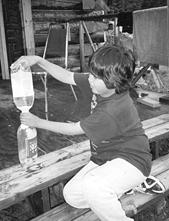Alaska Science Camps, Fairs & Experiments
ANKN is a resource for compiling and exchanging information
related to Alaska Native knowledge systems and ways of knowing. We
are pleased to create and distribute a variety of publications
that assist Native people, government agencies,
educators and the general public in gaining access to the knowledge
base that Alaska Natives have acquired through cumulative experience
over millennia.
TO ORDER THIS PUBLICATION:
Contact the ANKN
offices at 907-474-1902 or email uaf-cxcs@alaska.edu. Experiments
 Introduction Introduction
Ideas for science projects are endless.
Science inquiry involves exploring and adventure. There is no better
place for science exploration than villages as there are so many
questions that have not been asked or answered by scientists. A
village project could be the first of its kind.
This book shows students how to pick and develop an exciting
project.
Science projects start with questions.
- Why does this happen?
- Why did my grandpa do it that way?
- What is the reason for shaping it like that?
- What material is the most durable for this purpose?
- Etc.
The question should come from your personal life, from a problem,
from something you have wondered about for a while.
A science project is exploring the world of how and why.
There are three types of projects:
- Collections
- Demonstrations
- Experiments
Collections
Lower grades do collections. Students learn about shapes, sizes,
how something feels, what is different, what is similar. They learn
how to accurately observe, compare and record data. Collections might
be of leaves, rocks, shells, types of nails, pictures, etc. Organize
the collection in the way people can easily understand. Record when
and where samples were collected. See the list for suggested
collections.
Demonstrations
Demonstrations show how an activity is done, how something is made
or operated. Middle grades often do demonstrations. A demonstration
might be of how to make a deadfall trap, throw a spear with an
atlatl, reload bullets, render seal oil, sharpen tools to work with
wood, store berries, etc.
A student should identify the science principles involved
in a
demonstration. A deadfall trap involves understanding friction and
gravity, kinetic and potential energy, as well as animals eating
habits. Throwing a spear with an atlatl involves u uderstanding
levers, wind resistance, balance, and inertia. Rendering seal oil
involves understanding heat and chemical reactions as well as facts
about seals.
Experiment
A good experiment is doing a comparison using a fair test. We
could compare which size shot is most effective in hunting geese, #2
or #4. We could compare seal oil with vegetable oil in a lamp. We
could compare one fishing lure against another when hooking through
the ice.
A good experiment is simply a fair test. If I test my shotgun
with
#2 shot on a windy day and #4 shot on a calm day, that isn't a fair
test. If I use a big wick in the seal oil lamp and a small one in the
vegetable oil lamp, that isn't a fair test. If I use one fishing lure
in shallow water and the other lure in deep water, that also isn't a
fair test.
Observe and Think Experiments
While we would like to control the experiment, often the variables
are far out of our control, like the amount of snowfall in a winter,
the activity of the northern lights, or the conditions for a good
berry year. We must observe, identify what is influencing the
outcome, record, compare, and think about our data in order to come
to a good scientific conclusion.
Is there a connection between the height of the fireweed in
September and the amount of snow the following winter? We control
none of the variables. We must observe and measure accurately for
several years and then think about the data before coming to a
conclusion.
Will the river flood this year? What are the conditions? We
control none of them. We must measure, record, compare, and think
about the facts. We need the data from several years before we can
come to a conclusion to the question. Knowing the answer could save
much trouble for a village.
|